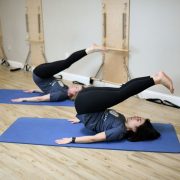When Gyms Reopen — Will Your Body be Ready?
The state of New Hampshire is slowly reopening, and we are so excited that small-group fitness classes can return to gyms and studios on June 1st! While many businesses, including ours, have adapted by offering online services — most clients we speak with can’t wait to get back in the studio again.
The big question is — will your body be ready?
If you’ve stuck with your strength and mobility routine and have been working out regularly from home, then you have a better chance than most to bounce right back.
But not everyone has taken advantage of online virtual exercise services, and many I speak with have opted to do nothing and just wait. Many have resorted to more frequent walking, running, or biking as a substitute for their usual exercise routines.
Any physical activity is better than no physical activity, but daily cardio is not the same as strength training. It’s just not going to be enough to get you by if your plan is to jump right back into the same pre-Covid workout routine that you left behind.
It takes months to gain appreciable muscle strength and improve mobility… but it only takes two to three weeks to lose it all.
The biggest mistake that I expect to see once gyms and even our own Pilates studio reopens is that people will assume their body is ready to pick back up exactly where it left off. And within about two to three weeks of that, injuries WILL start to happen.
What can you do?
If you’re not in any pain, but all you’ve been doing is cardio, then it’s a good idea to start incorporating strength and mobility back into your routine now. Your body will be much happier when it gets back into the gym or studio, and you’ll be less likely to experience some kind of injury. My best recommendation is to utilize the online services that your favorite gym or studio already offers — or find a facility that is offering them. In our studio, for example, we have online virtual Pilates classes daily. We guide you through the movements using precise cueing, and watch you while you’re moving. This allows us to give you in the moment corrections and make sure that you’re getting the most out of your workout. While it’s not exactly the same as your instructor being right there next to you, it’s the next best thing.
If you’re already experiencing pain or stiffness, perhaps because you’ve been walking or running more than you’re used to, you’ll want to talk to a movement specialist like us before you jump back into your previous exercise routine.
We know how to screen your muscles and joints properly, and can guide you toward not only getting rid of your pain, but we will also ensure that you’re set up to thrive in your workouts once we’re allowed to reopen again. Another big misconception I see is that people assume their pain will just go away once they start exercising again. While that may be true for some, most of the time it goes the other way, and your pain either gets worse or manifests itself somewhere else because your body starts to compensate for the problem.
I spoke with a gentleman earlier this week who was suffering from knee pain and stiffness because he went from walking 2-3 miles per week to walking 2-3 miles per DAY with his wife. He wants to get back on the golf course, and due to the restrictions on using golf carts, more walking is going to be necessary. His knee won’t be able to handle that in its current state, plus it will get worse if he pushes it. So I’m excited that he took us up on our offer to talk for free about what was going on with his knee. Now we’re going to get him the help he needs!
If you have any questions about pain that you might be experiencing, or want to ask about getting into a Pilates class this June, give us a call!
We are still offering FREE Zoom or in-person consultations to help people figure out what to do about their pain while they are stuck at home or slowly re-entering the world.



